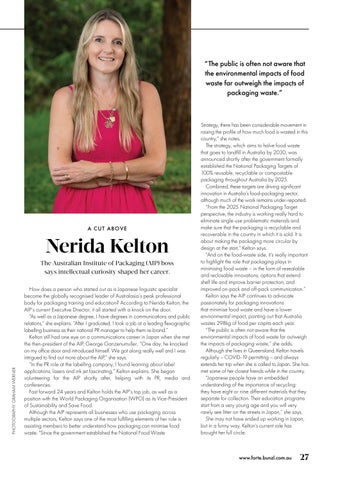“The public is often not aware that the environmental impacts of food waste far outweigh the impacts of packaging waste.”
A CUT ABO VE
Nerida Kelton
PHOTOGRAPHY: GRAHAM WERNER
The Australian Institute of Packaging (AIP) boss says intellectual curiosity shaped her career. How does a person who started out as a Japanese linguistic specialist become the globally recognised leader of Australasia’s peak professional body for packaging training and education? According to Nerida Kelton, the AIP’s current Executive Director, it all started with a knock on the door. “As well as a Japanese degree, I have degrees in communications and public relations,” she explains. “After I graduated, I took a job at a leading flexographic labelling business as their national PR manager to help them re-brand.” Kelton still had one eye on a communications career in Japan when she met the then-president of the AIP, George Ganzenumuller. “One day, he knocked on my office door and introduced himself. We got along really well and I was intrigued to find out more about the AIP,” she says. “In the PR role at the labelling company, I found learning about label applications, lasers and ink jet fascinating,” Kelton explains. She began volunteering for the AIP shortly after, helping with its PR, media and conferences. Fast forward 24 years and Kelton holds the AIP’s top job, as well as a position with the World Packaging Organisation (WPO) as its Vice-President of Sustainability and Save Food. Although the AIP represents all businesses who use packaging across multiple sectors, Kelton says one of the most fulfilling elements of her role is assisting members to better understand how packaging can minimise food waste. "Since the government established the National Food Waste
Strategy, there has been considerable movement in raising the profile of how much food is wasted in this country,” she notes. The strategy, which aims to halve food waste that goes to landfill in Australia by 2030, was announced shortly after the government formally established the National Packaging Targets of 100% reusable, recyclable or compostable packaging throughout Australia by 2025. Combined, these targets are driving significant innovation in Australia’s food-packaging sector, although much of the work remains under-reported. “From the 2025 National Packaging Target perspective, the industry is working really hard to eliminate single-use problematic materials and make sure that the packaging is recyclable and recoverable in the country in which it is sold. It is about making the packaging more circular by design at the start,” Kelton says. “And on the food-waste side, it’s really important to highlight the role that packaging plays in minimising food waste – in the form of resealable and reclosable innovations, options that extend shelf life and improve barrier protection, and improved on-pack and off-pack communication.” Kelton says the AIP continues to advocate passionately for packaging innovations that minimise food waste and have a lower environmental impact, pointing out that Australia wastes 298kg of food per capita each year. “The public is often not aware that the environmental impacts of food waste far outweigh the impacts of packaging waste,” she adds. Although she lives in Queensland, Kelton travels regularly – COVID-19 permitting – and always extends her trip when she is called to Japan. She has met some of her closest friends while in the country. “Japanese people have an embedded understanding of the importance of recycling: they have eight or nine different materials that they separate for collection. Their education programs start from a very young age and you will very rarely see litter on the streets in Japan,” she says. She may not have ended up working in Japan, but in a funny way, Kelton’s current role has brought her full circle.
www.forte.bunzl.com.au
27












